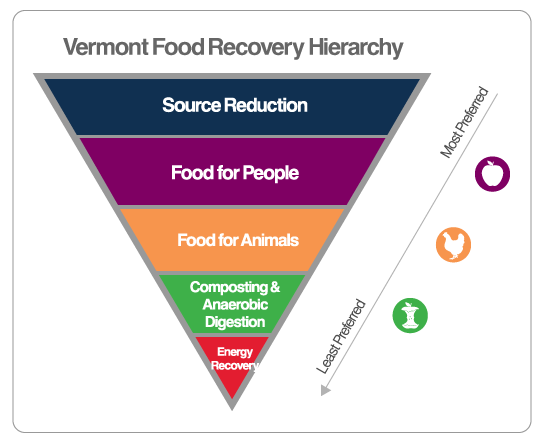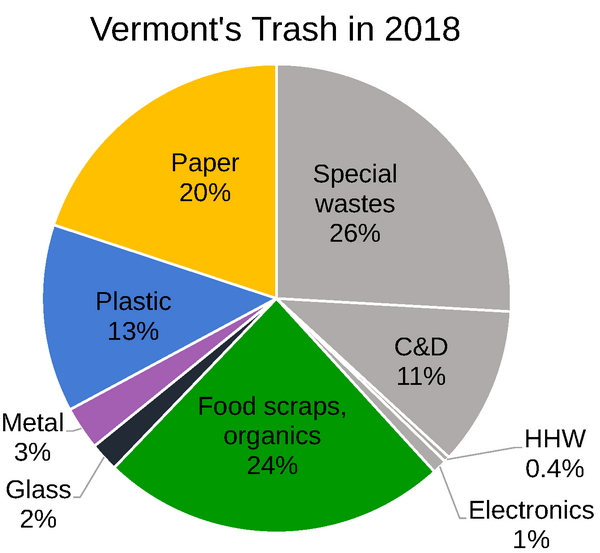Act 148: Vermont’s Universal Recycling Law
Many of the materials Vermonters historically threw away are resources that can be recycled or composted instead. These materials take up valuable space in Vermont's only landfill that is needed for materials that have no other disposal option. These are some of the reasons why the Vermont Legislature unanimously passed the Universal Recycling Law (Act 148) in 2012, which bans the three categories of materials from the trash in Vermont:
The pie chart demonstrates that Vermonters are still not diverting everything that is recyclable or compostable from the landfill. Do your part to learn what goes in your recycling bin and how to reduce and manage food waste.

Food Recovery Hierarchy
Act 148 also established Vermont's Food Recovery Hierarchy, which recommends the best uses of food waste in order of most to least preferred:
- Reduce food waste (you could save money!)
- Donate edible food
- Feed livestock
- Compost on-site, or collect food scraps for composting
Separate from Vermont's Food Recovery Hierarchy, the EPA has a Wasted Food Scale which ranks most preferred to least preferred diversion strategies of wasted food. They developed the scale after compiling a 2023 Report entitled From Field to Bin: The Environmental Impacts of U.S. Food Waste Management.
Residents
As of July 1, 2020, all food scraps, including from residents, were banned from the landfill. Containers for collecting food scraps are available at the District Transfer Station. Residents have several options for managing food scraps:
- Compost in your backyard or compost indoors with worms.
- Use a Green Cone Solar Digester in your yard.
- Feed scraps to chickens or pigs.
- Bring scraps to your town drop-off location or the District Transfer Station.
- Get scraps picked up by a waste hauler that offers curbside collection of food scraps. (Haulers are not required to offer food scrap collection to all residents.)
Have more questions? Check out our Frequently Asked Questions or contact us.
Leaf and yard waste can be composted at home or taken to a town drop-off location seasonally. Leaf and yard debris and natural wood are also accepted at the District Transfer Station.
Residents are required to separate blue-bin recyclables from the trash. Licensed haulers and town drop-off locations accept recyclables from residents. Recycling bins are available at the District Transfer Station for residents.
Businesses, Schools & Organizations
All businesses, schools, institutions, and other entities that generate food scraps are required to divert their food scraps from the landfill since July 1, 2020. Learn how your school or business can keep food scraps out of the trash.
Leaf and yard waste and natural wood are accepted at the District Transfer Station. Businesses and organizations are also required to separate blue-bin recyclables from the trash. Licensed haulers, town drop-off locations, and the District Transfer Station accept recyclables from businesses.
Events
Public and private events are also required to comply with the Universal Recycling Law. Learn more about requirements and resources for handling recyclables and food scraps at events.
More information
Other features of the Universal Recycling Law are meant to make the disposal bans convenient, consistent, and cost-effective, including:
Parallel Collection: Waste haulers and drop-off centers that collect trash are required to offer recycling collection. Drop-off centers are also required to accept food scraps. Waste haulers are required to offer collection of food scraps to non-residential customers and apartments of four or more units unless another hauler is willing to provide that service.
Unit-Based Pricing or "Pay-As-You-Throw": Waste haulers and drop-off centers must bundle the costs of recycling and trash collection into one fee for residential customers.
Public Space Recycling: Any trash container in a public space (public buildings or land) must be accompanied by a recycling container. Bathrooms are exempt.
Visit the Vermont Agency of Natural Resources's website for information about Act 148, including a summary of the law, fact sheets, and many additional resources.
View a list of downloadable Universal Recycling Symbols, posters and resources.
What about food scraps?
Still have questions about managing food scraps? Check out our FAQ

